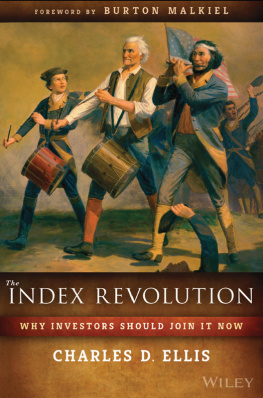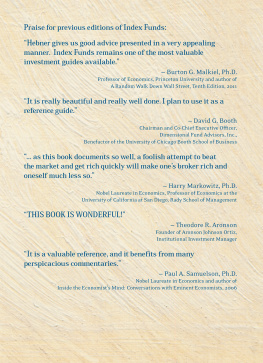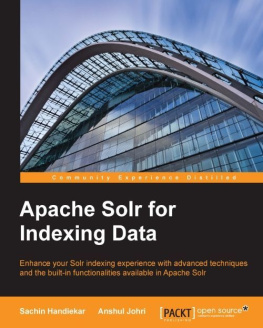
Cover image: Spirit of 76 painting Steve McAlister/Getty Images, Inc.
Cover design: Paul McCarthy
Copyright 2016 by Charles D. Ellis. All rights reserved.
Published by John Wiley & Sons, Inc., Hoboken, New Jersey.
Published simultaneously in Canada.
No part of this publication may be reproduced, stored in a retrieval system, or transmitted in any form or by any means, electronic, mechanical, photocopying, recording, scanning, or otherwise, except as permitted under Section 107 or 108 of the 1976 United States Copyright Act, without either the prior written permission of the Publisher, or authorization through payment of the appropriate per-copy fee to the Copyright Clearance Center, Inc., 222 Rosewood Drive, Danvers, MA 01923, (978) 750-8400, fax (978) 646-8600, or on the Web at www.copyright.com. Requests to the Publisher for permission should be addressed to the Permissions Department, John Wiley & Sons, Inc., 111 River Street, Hoboken, NJ 07030, (201) 748-6011, fax (201) 748-6008, or online at www.wiley.com/go/permissions.
Limit of Liability/Disclaimer of Warranty: While the publisher and author have used their best efforts in preparing this book, they make no representations or warranties with respect to the accuracy or completeness of the contents of this book and specifically disclaim any implied warranties of merchantability or fitness for a particular purpose. No warranty may be created or extended by sales representatives or written sales materials. The advice and strategies contained herein may not be suitable for your situation. You should consult with a professional where appropriate. Neither the publisher nor author shall be liable for any loss of profit or any other commercial damages, including but not limited to special, incidental, consequential, or other damages.
For general information on our other products and services or for technical support, please contact our Customer Care Department within the United States at (800) 762-2974, outside the United States at (317) 572-3993 or fax (317) 572-4002.
Wiley publishes in a variety of print and electronic formats and by print-on-demand. Some material included with standard print versions of this book may not be included in e-books or in print-on-demand. If this book refers to media such as a CD or DVD that is not included in the version you purchased, you may download this material at http://booksupport.wiley.com. For more information about Wiley products, visit www.wiley.com.
Library of Congress Cataloging-in-Publication Data:
ISBN 9781119313076 (Hardcover)
ISBN 9781119313090 (ePDF)
ISBN 9781119313083 (ePub)
Foreword
As a person who has believed in indexing all my life, I am delighted to add my voice in support of the important message of this book. The Index Revolution is not only a history of the growth of indexing over the past 40 years, but also a call to those who may have been slow to accept this revolutionary method of portfolio management. If you are still attracted to high-expense, actively managed mutual funds (or, worse, if you have chosen to invest in hedge funds), Charley Elliss succinct arguments as well as his marvelous anecdotes should leave no lingering doubts in your mind: index investing represents a superior investment strategy, and everyone should use index funds as the core of their investment portfolios.
Every year, mutual-fund advertisements proudly declare that this year will be a stock-pickers market. They may admit that during the previous year it was all right to be invested in a simple index fund, but they say that the value of professional investment management will become apparent in the current year. Barrons ran a cover story in 2015 and made the same case in 2016 that active portfolio managers would recapture their lost glory. In early 2014 The Wall Street Journal ran an article predicting that 2014 would be a stock-pickers market. Money managers have a number of clichs they use to promote their high-priced services, and stock-pickers market is one of their favorites. But year after year, when the results come in, low-cost index funds prove their worth as the optimal way to invest.
Indexing outperforms in both bull and bear markets. Active management will not protect you by moving out of stocks when markets decline. No one can consistently time the market. There is no evidence to support the claim that active managers do better when there is more or less dispersion in the returns for individual stocks. Nor is it the case that indexing does worse during periods of rising interest rates. While in every year there will always be some actively managed funds that beat the market, the odds of your finding one are stacked against you. And there is little persistence in mutual fund returns. The fact that a fund is an outperformer in one year is no guarantee that it will be a winner in the next. Indeed, Morningstar, the mutual fund rating company, found that its ratings, based on past performance, were not useful in predicting future returns. Their five-star-rated funds, the top performers, actually did worse over the next year than the lowest one-star-rated Morningstar Funds.
Morningstar found that the only variable that was reliably correlated with the next years performance was the funds expense ratio. Funds with low expense ratios and low turnover tend to outperform funds with high turnover and high expenses (even before considering the adverse tax effects of high-turnover funds). Of course, the quintessential low-turnover, low-expense funds are index funds, which simply buy and hold all the stocks in a particular market and do not trade from stock to stock.
Standard & Poors Dow Jones Indices published a statistical analysis in 2016 detailing the dismal record of active portfolio managers: As is typically the case, about two-thirds of active large-capitalization managers underperformed the S&P 500 large-cap index during 2015. Nor were managers any better in the supposedly less efficient, small-capitalization universe. Almost three-quarters of small-cap managers underperformed the S&P Small-Cap Index. When S&P measured performance over a longer time period, the results got worse. Over 80 percent of large-cap managers and almost 90 percent of small-cap managers underperformed their benchmark indexes over a ten-year period through December 2015.
The same findings have been documented in international markets. Even in the less efficient emerging markets, index funds regularly outperform active funds. The very inefficiency of emerging markets (including large bid-asked spreads, market impact costs, and a variety of stamp taxes on transactions) makes the strategy of simply buying and holding a broad indexed portfolio an optimal strategy in these markets, too. And indexing has proved its merit in the bond markets as well. The high-yield bond market is often considered to be best accessed via active investing, as passive vehicles have structural constraints that limit their flexibility and ability to deal with credit risk. Nevertheless, Standard & Poors found that the 10-year results through 2015 for the actively managed high-yield funds category show that over 90 percent of funds underperformed their broad-based benchmarks.
It is true that in every period there are some managers who do outperform. But there is little consistency. The best managers in one period are usually not the same as the outperformers in the next. And even celebrity managers like William Miller, who racked up market-beating returns over a decade, underperformed over the next several years. Your chances of picking the best managers for the next decade are virtually nil. You are far more likely to end up with a typical underperforming, high-priced manager who will produce returns for you that are lower than index returns by an amount about equal to the difference in the fees that are charged. Buying a low-cost index fund or exchange-traded fund (ETF) is the superior investment strategy. Trying to predict the next star manager is, in Charley Elliss famous words, a losers game.
Next page





